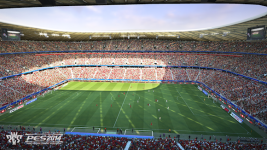LordCrash
Nerd
- Mitglied seit
- 16.04.2004
- Beiträge
- 9.599
- Reaktionspunkte
- 1.173
Pro Evolution Soccer 2014's Fox in the Box
How Konami's new engine and a taste for innovation have made PES 2014 a new start for the long-running series.
by Daniel Krupa, July 31, 2013
Pro Evolution Soccer 2014 marks something of a soft reboot for the long-running football series. With an impressive new engine in tow – Konami’s feted Fox Engine no less – and a strong localisation team now installed at Konami’s European office, it’s clear that PES 2014 is doing its best to move the series forward, to innovate and impress audiences old and new. And while it’s still unclear about how some of its more ambitious features will actually work – we’ll come to those later – it’s definitely worth keeping an eye on during the pre-season.
Let’s start off by being quite superficial. PES 2014 looks fantastic, and is a significant improvement on previous instalments. The stadium I played in were highly-detailed, atmospheric, and the crowd didn’t feel like an afterthought – they display custom banners and signs, and will slowly filter to the car park if the home team takes a beating.
But by far the most eye-catching aspect of PES 2014 is the players. The benefits of the new Fox Engine are evident and very, very impressive. Skin textures look incredible – in replays and post-goal celebrations, you can see pores, veins bulging beneath the skin, and sweat dripping from the brows of your more industrious players. And the likenesses of marquee players such as Balotelli, Ozil, and Schweinsteiger are genuinely uncanny. The preview build I spent time with was limited to Bayern Munich, Santos, and the German and Italian national teams, so I'm unsure how many players will have this level of detail.

During a game, when the camera pulls out to the default television angle, much of this detail is inevitably obscured, but during goal celebrations and action-replays you’ll marvel at its high-level realism, from the improved grass texture to the way fabric billows when players run. It’s not quite next-gen, but it’s arguably the best-looking football game the current generation of consoles has produced so far.
From this zoomed-out perspective, what’s more impressive is the way players move and interact. PES 2014 feels more physical than ever before. Players now have mass, solidity, and rather appropriately this is down to a new bit of tech called the M.A.S.S. System (Motion Animation Stability System, if you were wondering). It gives players not only self-awareness of when they’re under pressure but also the physicality to respond – they’ll stick out an arm to hold-up play or stick a foot out if they think they can intercept a wayward pass.
In PES 2014 not all players are created equally and you’ll quickly learn to play to your team’s strength. Centre-backs and holding midfielders feel exactly like they should – strong and imposing, but less technically gifted, so you’re less likely to go on mazy runs with someone like Javi Martinez. Yet when the ball goes to a winger like Franck Ribéry or a creative midfielder like Bastian Schweinsteiger, you instantly feel empowered and imaginative. They’re faster, can turn on a sixpence, and have a much greater range of passing.

This mixture of brawny, defensively-minded players and more nimble, attacking ones creates gameplay underpinned by a cat-and-mouse dynamic. No matter who you’re controlling, defender and attacker, you must decide between a low risk/low return or high risk/high return strategy. For example, if Mario Balotelli receives the ball in a forward position, you could simply choose to lay-off the ball to the nearest team. It’s a low risk decision, and consequently the benefits are unremarkable – you’ll retain possession, yes, but it’s highly unlikely to put you in a goal-scoring position.
Conversely, if you’re feeling lucky, you can lure in the defenders and bet on Balotelli’s innate speed and skill (tricks are now performed simply by combining movement on the two analogue sticks) to put you through on goal. While tricks are a potent skill to learn, misjudge the situation or the position of the incoming defender, and there’s a very good chance you’ll give away the ball (and look a bit of an idiot in the process). This decision-making process, of weighing out the consequences, also extends to defending, which is much simpler this year. Holding down X is the easy option, allowing you to shadow the player in possession without applying much pressure; if you combine it with R1, you’ll get tighter, close enough to jostle with the opposition; and if you’re feeling really brave, you can of course lunge in for a sliding tackle.

Those are the basic mechanics, but PES 2014 is also championing some ambitious yet more intangible features. ‘Combination Play’ is a system that allows you to control the movement of your AI teammates. There’s a menu of preset behaviour patterns – such as swap positions, attack down the right, and so on – and you can decide where on the pitch these tactics are deployed. The pitch is divided into 11 squares and these behaviours can be assigned to individual areas. Say you want to play a really attacking game, you can assign the overlapping fullback behaviour to one of the squares around the halfway line. When you find yourself in this position, you can activate the behaviour manually by double tapping the left trigger. Sound fiddly? Perhaps, but this will ultimately depend on how the game will communicate the power of this feature to the wider audience, with the right UI this could be a powerful new addition, giving a new tactical layer to the game.
‘Heart’ is another one of those more nebulous features. It sounds like something from Captain Planet but it’s an attempt to introduced one of football’s most ambiguous charms into PES 2014. It’s the symbiotic relationship between the individual player and the crowd. Each player will have a ‘heart’ stat, which will be visible as an icon on the tactics screen. If the match is evenly balanced, and a player like Robben sets off on some dazzling runs, he has the ability to lift the mood of the crowd, which in turn will lift the entire team. It’s hoped that this feature will allow for FA Cup-style giant slayings, with it bringing parity to mismatched teams. In reality, it’s a tricky feature to implement – balancing the shift in stats will have to be deft to avoid unbalancing the wider game. But again, it’s symptomatic of PES 2014’s approach this year, defined by innovation.
If you're coming to PES 2014, after a few years away, you'll find it challenging and reward, visually impressive, and full of new ideas. Konami has rested upon those laurels of years ago, it's gone back to the drawing board and found returned with something very promising.
Quelle: Pro Evolution Soccer 2014's Fox in the Box - IGN
How Konami's new engine and a taste for innovation have made PES 2014 a new start for the long-running series.
by Daniel Krupa, July 31, 2013
Pro Evolution Soccer 2014 marks something of a soft reboot for the long-running football series. With an impressive new engine in tow – Konami’s feted Fox Engine no less – and a strong localisation team now installed at Konami’s European office, it’s clear that PES 2014 is doing its best to move the series forward, to innovate and impress audiences old and new. And while it’s still unclear about how some of its more ambitious features will actually work – we’ll come to those later – it’s definitely worth keeping an eye on during the pre-season.
Let’s start off by being quite superficial. PES 2014 looks fantastic, and is a significant improvement on previous instalments. The stadium I played in were highly-detailed, atmospheric, and the crowd didn’t feel like an afterthought – they display custom banners and signs, and will slowly filter to the car park if the home team takes a beating.
But by far the most eye-catching aspect of PES 2014 is the players. The benefits of the new Fox Engine are evident and very, very impressive. Skin textures look incredible – in replays and post-goal celebrations, you can see pores, veins bulging beneath the skin, and sweat dripping from the brows of your more industrious players. And the likenesses of marquee players such as Balotelli, Ozil, and Schweinsteiger are genuinely uncanny. The preview build I spent time with was limited to Bayern Munich, Santos, and the German and Italian national teams, so I'm unsure how many players will have this level of detail.

During a game, when the camera pulls out to the default television angle, much of this detail is inevitably obscured, but during goal celebrations and action-replays you’ll marvel at its high-level realism, from the improved grass texture to the way fabric billows when players run. It’s not quite next-gen, but it’s arguably the best-looking football game the current generation of consoles has produced so far.
From this zoomed-out perspective, what’s more impressive is the way players move and interact. PES 2014 feels more physical than ever before. Players now have mass, solidity, and rather appropriately this is down to a new bit of tech called the M.A.S.S. System (Motion Animation Stability System, if you were wondering). It gives players not only self-awareness of when they’re under pressure but also the physicality to respond – they’ll stick out an arm to hold-up play or stick a foot out if they think they can intercept a wayward pass.
In PES 2014 not all players are created equally and you’ll quickly learn to play to your team’s strength. Centre-backs and holding midfielders feel exactly like they should – strong and imposing, but less technically gifted, so you’re less likely to go on mazy runs with someone like Javi Martinez. Yet when the ball goes to a winger like Franck Ribéry or a creative midfielder like Bastian Schweinsteiger, you instantly feel empowered and imaginative. They’re faster, can turn on a sixpence, and have a much greater range of passing.

This mixture of brawny, defensively-minded players and more nimble, attacking ones creates gameplay underpinned by a cat-and-mouse dynamic. No matter who you’re controlling, defender and attacker, you must decide between a low risk/low return or high risk/high return strategy. For example, if Mario Balotelli receives the ball in a forward position, you could simply choose to lay-off the ball to the nearest team. It’s a low risk decision, and consequently the benefits are unremarkable – you’ll retain possession, yes, but it’s highly unlikely to put you in a goal-scoring position.
Conversely, if you’re feeling lucky, you can lure in the defenders and bet on Balotelli’s innate speed and skill (tricks are now performed simply by combining movement on the two analogue sticks) to put you through on goal. While tricks are a potent skill to learn, misjudge the situation or the position of the incoming defender, and there’s a very good chance you’ll give away the ball (and look a bit of an idiot in the process). This decision-making process, of weighing out the consequences, also extends to defending, which is much simpler this year. Holding down X is the easy option, allowing you to shadow the player in possession without applying much pressure; if you combine it with R1, you’ll get tighter, close enough to jostle with the opposition; and if you’re feeling really brave, you can of course lunge in for a sliding tackle.

Those are the basic mechanics, but PES 2014 is also championing some ambitious yet more intangible features. ‘Combination Play’ is a system that allows you to control the movement of your AI teammates. There’s a menu of preset behaviour patterns – such as swap positions, attack down the right, and so on – and you can decide where on the pitch these tactics are deployed. The pitch is divided into 11 squares and these behaviours can be assigned to individual areas. Say you want to play a really attacking game, you can assign the overlapping fullback behaviour to one of the squares around the halfway line. When you find yourself in this position, you can activate the behaviour manually by double tapping the left trigger. Sound fiddly? Perhaps, but this will ultimately depend on how the game will communicate the power of this feature to the wider audience, with the right UI this could be a powerful new addition, giving a new tactical layer to the game.
‘Heart’ is another one of those more nebulous features. It sounds like something from Captain Planet but it’s an attempt to introduced one of football’s most ambiguous charms into PES 2014. It’s the symbiotic relationship between the individual player and the crowd. Each player will have a ‘heart’ stat, which will be visible as an icon on the tactics screen. If the match is evenly balanced, and a player like Robben sets off on some dazzling runs, he has the ability to lift the mood of the crowd, which in turn will lift the entire team. It’s hoped that this feature will allow for FA Cup-style giant slayings, with it bringing parity to mismatched teams. In reality, it’s a tricky feature to implement – balancing the shift in stats will have to be deft to avoid unbalancing the wider game. But again, it’s symptomatic of PES 2014’s approach this year, defined by innovation.
If you're coming to PES 2014, after a few years away, you'll find it challenging and reward, visually impressive, and full of new ideas. Konami has rested upon those laurels of years ago, it's gone back to the drawing board and found returned with something very promising.
Quelle: Pro Evolution Soccer 2014's Fox in the Box - IGN


.gif)












